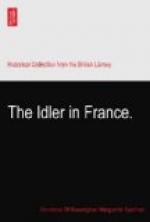In the Church of St. Martha we saw a relic of the barbarism of the dark ages, in the shape of a grotesque representation of a dragon, called the Tarasque. This image is formed of wood, rudely painted in gandy colours.
Twice a-year it is borne through the streets of Tarascon, in commemoration of the destruction of a fabulous monster that long frequented the Rhone, and devoured many of the inhabitants of the surrounding country, but was at length vanquished by St. Martha; who, having secured it round the neck by her veil, delivered it to the just vengeance of the Tarascons. This legend is received as truth by common people, and our guide informed us that they warmly resent any doubt of its authenticity.
The monument of St. Martha is shown in the church dedicated to her, and her memory is held in great reverence at Tarascon.
The country between this place and Tarascon is fertile and well cultivated, and the cheerfulness of its aspect presents a striking contrast to the silence and solitude of the town. The streets, however, are as clean as those of Holland, and the inhabitants are neat and tidy in their attire.
The houses are for the most part old and dilapidated, looking in nearly as ruined a condition as the fragments of antiquity which date so many centuries before them. Nevertheless, some of the streets and dwellings seem to indicate that a spirit of improvement is abroad.
Our hotel is a large, crazy, old mansion, reminding me of some of those at Shrewsbury; and its furniture appears to be coeval with it, as nothing can be more homely or misshapen. Oak and walnut-tree chairs, beds, and tables form the chief part, and these are in a very rickety condition; nevertheless, an air of cleanliness and comfort pervades the rooms, and with the extreme rusticity of the ameublement, give one the notion of being in some huge old farm-house.
Nor is the manner of the good hostess calculated to dispel this illusion. When our three carriages drove to her door, though prepared for our arrival by the courier, she repeatedly said that her poor house had no accommodation for such guests, and we had some difficulty in persuading her that we were easily satisfied.
She had donned her fete dress for our reception, and presented a very picturesque appearance, as she stood smiling and bustling about at the door. She wore a high cap reminding me of those of the women in Normandy: brown stays; linsey-woolsey, voluminous petticoats; handkerchief and apron trimmed with rich old-fashioned lace; and long gold ear-rings, and chain of the same material, twisted at least ten times round her neck.
She explained to us, in a patois not easily understood, that her house was only frequented by the farmers, and their wives and daughters, who attended the fetes, or occasionally by a stray traveller who came to explore the antiquities.
Before I had travelled much on the Continent, I confess that the appearance of this dwelling would have rather startled me as a sejour for two days, but now I can relish its rusticity; for cleanliness, that most indispensable of all requisites to comfort, is not wanting.




